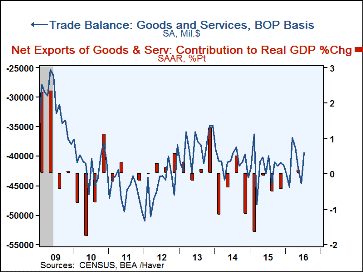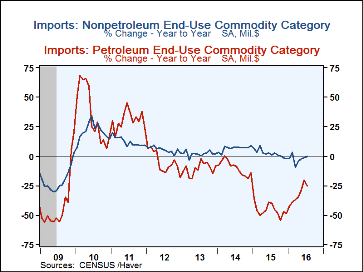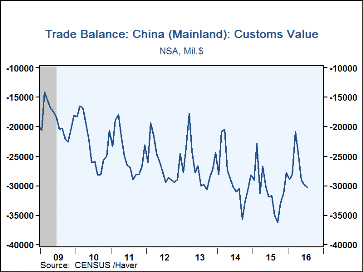 Global| Sep 02 2016
Global| Sep 02 2016U.S. Trade Deficit Narrows, Due Mainly to Surge in Soybean Exports
Summary
The U.S. trade deficit in goods and services decreased to $39.5 billion in July from a slightly revised $44.7 billion in June. The Action Economics Forecast Survey had expected a much more modest move to a $43.0 billion deficit. The [...]
The U.S. trade deficit in goods and services decreased to $39.5 billion in July from a slightly revised $44.7 billion in June. The Action Economics Forecast Survey had expected a much more modest move to a $43.0 billion deficit. The actual outcome is the result of a 1.9% increase in exports (-2.0% y/y) and an 0.8% decrease in imports (-1.8% y/y). The reduction in the deficit was driven mainly by two specific moves, a jump in soybean exports of $3.6 billion and a drop in petroleum imports of $628 million.
Among exports, total goods rose 3.0% (-2.6% y/y). This included a striking 34.0% surge in foods, feeds & beverages (34.2% y/y), mainly in soybeans. Autos & parts rose 3.0% (-4.3% y/y), and industrial materials & supplies gained 1.4% (-10.9% y/y). There were declines of 0.5% in capital goods (excluding autos) (-3.2% y/y), 0.1% in consumer goods (-2.0% y/y) and 12.2% in "other" goods (-11.6% y/y). Exports of services inched lower by 0.1% (-0.3% y/y). Transport was down 2.0% (-4.9% y/y), finance by 1.6% (-8.0% y/y), maintenance & repair by 1.4% (+15.9% y/y), and charges for intellectual property by 0.1% (-4.8% y/y). Other categories had gains, including travel of 1.3% (1.5% y/y), telecommunications 0.8% (7.1% y/y), government services 0.8% (-1.2% y/y) and other business services 0.1% (4.4%).
Imports of goods fell back in July by 1.0% (-2.4% y/y). The decline was led by consumer goods 3.0% (+1.6% y/y) and "other" goods 2.8% (+1.5% y/y), with lesser decreases in capital goods 1.5% (-1.5% y/y), and autos 0.2% (-4.9% y/y). On the other side, food, feeds & beverages imports grew 1.9% (+1.0% y/y). Interestingly, the total category of industrial supplies & materials imports rose 1.0% (-7.8% y/y) even as petroleum imports fell back somewhat. Nonmonetary gold and various metal products had the main increases. The value of energy-related petroleum imports did drop, by 5.0% (-27.4% y/y); the cost per barrel of crude oil was $41.02, up $1.64 from June, while the quantity of energy-related product imports fell 6.4% (-1.8% y/y), reversing much of a June surge. Services imports increased 0.2% (+1.2% y/y), as travel rose 1.0% (+7.8% y/y), telecommunications by 0.7%, intellectual property charges 0.5% (+0.2% y/y), finance and other business by 0.4% each (-4.3% y/y and +2.7% y/y, respectively). Maintenance & repair costs dropped 3.3% (-10.4% y/y), transport charges fell 1.0% (-1.7% y/y) and government services were down 0.7% (-11.7% y/y).
By country, the trade deficit with mainland China widened a bit further to $30.3 billion in July from $29.8 billion in June. Exports rose, by 3.8% (-3.7% y/y), and imports also rose, by 2.4% (-4.2% y/y). The trade balance with Japan was little changed at a deficit of $6.1 billion after June's $5.9 billion. Exports to Japan edged up a mere 0.1% (-1.8% y/y) but imports rose 2.0% (+2.7% y/y). The trade deficit with the European Union narrowed slightly again to $12.3 billion from $12.8 billion. Exports and imports to the EU-28 both decreased, reversing their June moves; exports fell 9.5% (unchanged y/y) and imports were down 7.7% (-8.6% y/y).
The international trade data can be found in Haver's USECON database. Detailed figures are available in the USINT database. The expectations figures are from the Action Economics Forecast Survey, which is carried in the AS1REPNA.
| Foreign Trade in Goods & Services (Current Dollars) | Jul | Jun | May | Y/Y | 2015 | 2014 | 2013 |
|---|---|---|---|---|---|---|---|
| U.S. Trade Deficit | $39.5 bil. | $44.7 bil. | $42.0 bil. | $39.9 bil. (7/15) |
$500.4 bil. | $490.2 bil. | $461.9 bil. |
| Exports of Goods & Services (% Chg) | 1.9 | 0.8 | -0.1 | -2.0 | -4.9 | 3.6 | 3.4 |
| Imports of Goods & Services (% Chg) | -0.8 | 1.9 | 1.5 | -1.8 | -3.7 | 4.0 | 0.0 |
| Petroleum (% Chg) | -5.0 | 19.4 | 8.4 | -25.1 | -45.5 | -9.6 | -11.0 |
| Nonpetroleum Goods (% Chg) | -0.7 | 1.2 | 1.5 | -0.2 | 2.2 | 6.5 | 2.0 |
Carol Stone, CBE
AuthorMore in Author Profile »Carol Stone, CBE came to Haver Analytics in 2003 following more than 35 years as a financial market economist at major Wall Street financial institutions, most especially Merrill Lynch and Nomura Securities. She has broad experience in analysis and forecasting of flow-of-funds accounts, the federal budget and Federal Reserve operations. At Nomura Securites, among other duties, she developed various indicator forecasting tools and edited a daily global publication produced in London and New York for readers in Tokyo. At Haver Analytics, Carol is a member of the Research Department, aiding database managers with research and documentation efforts, as well as posting commentary on select economic reports. In addition, she conducts Ways-of-the-World, a blog on economic issues for an Episcopal-Church-affiliated website, The Geranium Farm. During her career, Carol served as an officer of the Money Marketeers and the Downtown Economists Club. She has a PhD from NYU's Stern School of Business. She lives in Brooklyn, New York, and has a weekend home on Long Island.









